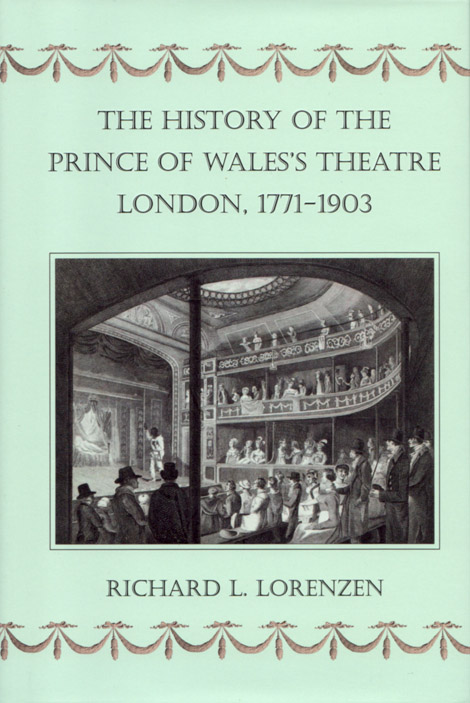THE HISTORY OF THE PRINCE OF WALES THEATRE, LONDON, 1771-1903 by Richard L. Lorenzen.
I thoroughly enjoyed this book. It is the history, as the title might suggest, of the old, not the current, Prince of Wales Theatre that existed in Tottenham Street between 1771 and 1903 when the building was demolished.
In 1771 a new concert hall was built on a plot of land just off London’s Tottenham Court Road. Amateur theatricals staged there by the aristocratic Pic-Nic Society soon aroused the hostility of the Patent Theatre managers, keen to protect their monopoly. The hall was refitted as a theatre in 1810 and for more than seventy years the little theatre in Tottenham Street was a busy place of entertainment for the neighbourhood and beyond. It underwent several name changes but is best known today as the Prince of Wales’s. The size of the playhouse, seating around 560 people, limited the scope of productions as well as potential revenues. In the early decades audiences’ insatiable appetite for variety meant bills dominated by lurid melodrama, pantomime, nautical drama and farce. Success was often elusive and changes in management frequent. In the 1860s, however, the intimate theatre proved the perfect space for the development of realistic drama and the theatre became a fashionable destination for London theatregoers. Many stars of the London stage appeared at the theatre in Tottenham Street in the course of the nineteenth century, including Madames Vestris and Celeste, Louisa Nisbett, John Hare, Marie Wilton, Squire Bancroft, Ellen Terry, Madge and William Kendal, Johnston Forbes-Robertson and Genevieve Ward. The longevity of the physical building was remarkable. The playhouse remained open for nearly a century. While it was renovated periodically, the building underwent no large-scale improvements and miraculously escaped fire. Finally, in 1882, it was judged to be unsafe and closed. The building was razed in 1903. This book gives a detailed account of the hundreds of artists who appeared at the playhouse as well as recording the notable variety of productions on the playbills. As a closely focused history of a single venue over more than a century, it adds invaluably to our knowledge of London theatre history.
Many fascinating and often little unknown facts emerge. The corner area between Oxford Street and Tottenham Court Road, sometimes called Fitzrovia or North Soho was a place of fairs and public entertainment but professional drama could only be performed under license or patent. These patents were closely guarded and other theatres were only allowed to put on amateur or musical shows. To get round this a straight play would often have a pianist playing inaudible in the wings so as to qualify the show as a musical. But the most surprising thing for me was the cost of tickets.
The price range was more or less the same as it was in the 1960s with the best seats costing about 6/- (that’s shillings, for you youngsters). The difference was that in the late eighteenth century that represented more that a week’s wages for a school teacher. Who ever said theatre was elitest?
Richard L. Lorenzen’s book is a scholarly yet very entertaining tome which will certainly please those interested in the story of theatre in the capital. Highly recommended.
- Hardcover: 256 pages
- Publisher: University of Hertfordshire Press (1 Jun 2014)
- ISBN-13: 978-1909291218
- Product Dimensions: 24.1 x 16.3 x 1.8 cm


